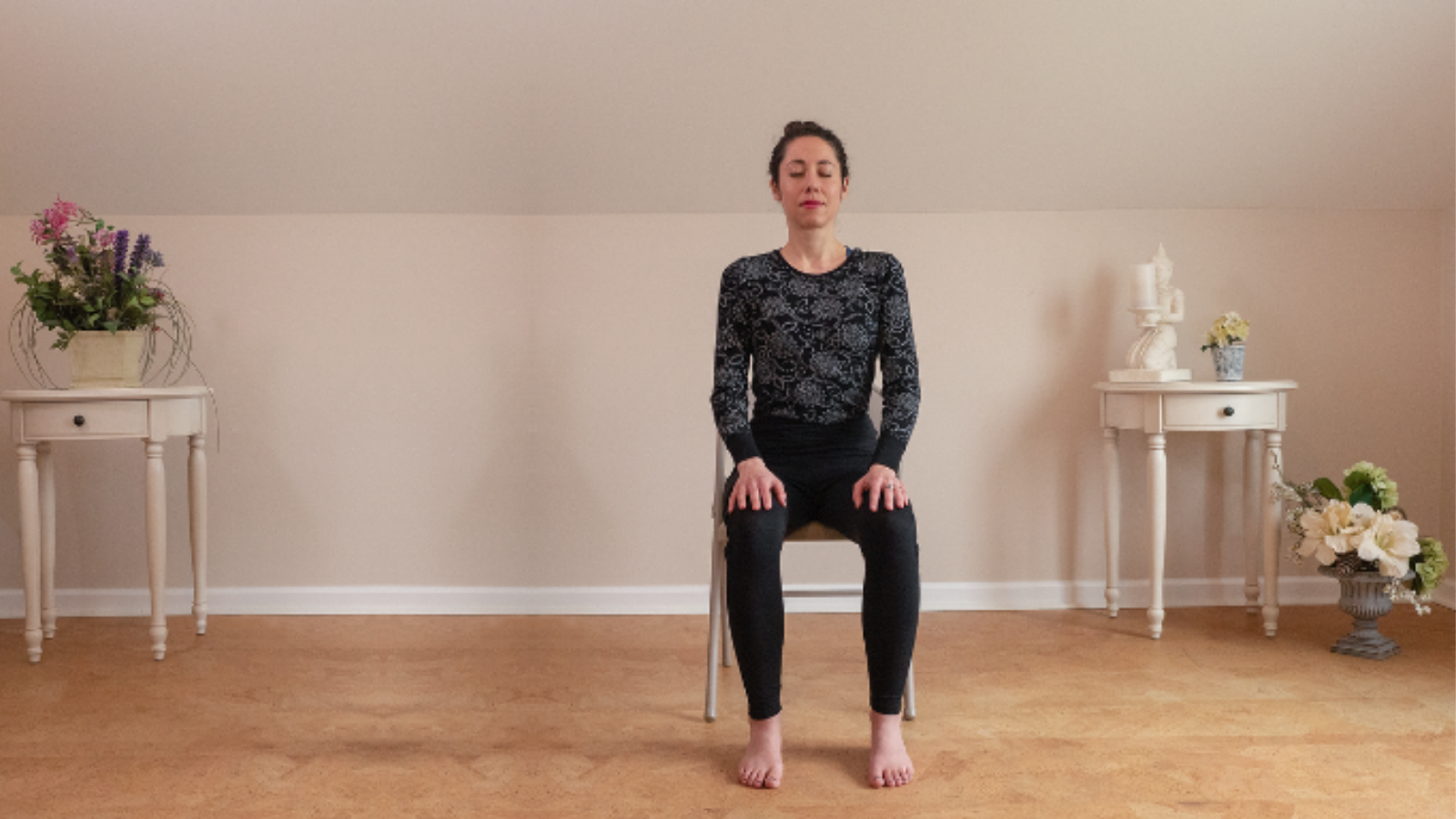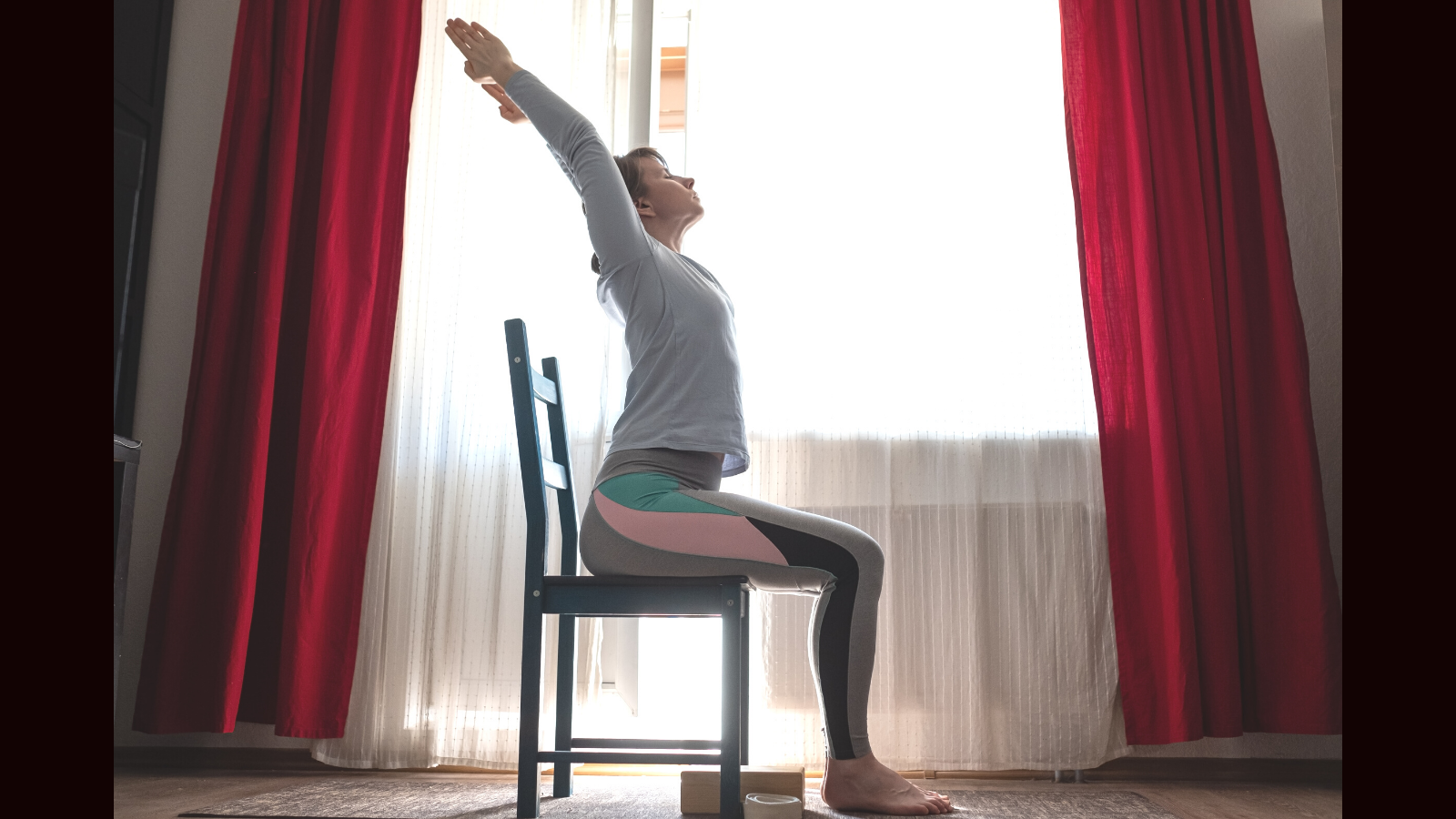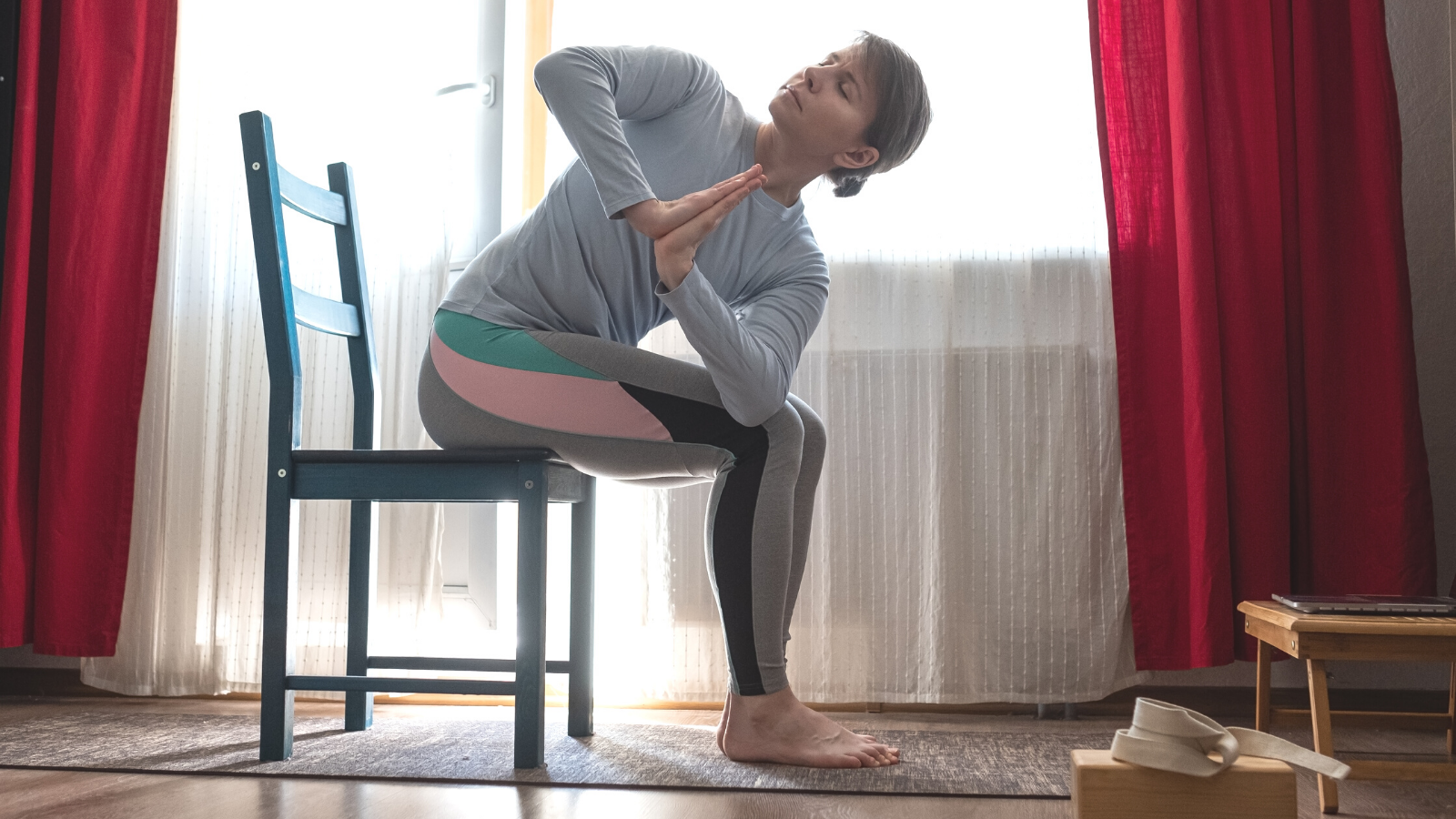Savor Your Food: Chair Yoga for Mindful Eating

Take a moment for honest reflection: are you a mindful eater? Mindless eating is common in today’s world, particularly with technology becoming more and more enmeshed in our daily lives. It sometimes feels as if modern life is getting more and more hectic. These distractions and pressures can lead us to eat while working, watching television, rushing to our next destination—anytime, doing anything, really. That can cause us to associate food with emotions while we also lose the sense of satiety that comes from truly enjoying our food. Chair yoga for mindful eating can counteract these tendencies.
To be fully clear, a focus on mindful eating can be totally separate from condemning anyone’s food choices. It’s not driven by a societal focus on appearance or vanity. There are significant health problems involved with eating that get out of balance, including obesity and eating disorders. Yet, it’s important to note that weight isn’t a direct indicator of health.
Many complex factors contribute to health. For example, it’s entirely possible that someone we might see as on the heavier side could be very athletic. In the same way, someone we might see as slender could be lacking in strength and cardiovascular endurance. There’s also a set point. Some research has shown that our bodies thrive at a particular range of weight and will always drift back to it, no matter how hard we try to be at a different weight. Fighting our bodies’ natural tendencies only leads to problems. Our bodies are smart and know what they need!
We share the following practice, chair yoga for mindful eating, to encourage greater awareness when it comes to eating. Many people can attest that, in the long run, it doesn’t feel good to eat just to eat or to feel a lack of agency over how one fuels their body. Mindful eating can turn that around to something much more enjoyable, holistically healthy, and empowering.
One should always consult his or her doctor before beginning yoga or any other somatic practice. And yoga should always be considered a complementary (rather than primary) treatment for diagnosable conditions. Yet a better experience of eating is possible through yoga for mindful eating.
Box Breath: Yoga for Mindful Eating

Tuning into our bodies can begin with something we’re always doing—breathing. The clear structure of this breath sequence can encourage balancing effort and ease, the aim of yoga asana. In turn, this can lead to more mindful eating.
- Sit in a chair. Slide-out toward the outer third of the seat so that your knees line up over your ankles. Place your hands on your thighs. Or if it feels better for you today, let your arms hang by your sides and face your palms forward.
- As you breathe in, feel a slight, gentle lift through your torso, as if you were a flower growing up toward the sun. At the same time, feel a stable grounding through your seat and your feet, roots growing down into the ground. Feel the easeful stability of your spine in its natural curves.
- Fix your gaze softly forward, or if it’s comfortable for you, close your eyes. Adjust your chin so that it’s parallel to the floor. Draw your shoulder blades down your back so that your collarbones broaden. Notice the space you have available for breathing. Then just notice your breathing as it is right now.
- Your foundation set, breathe in for 4 counts (try not to rush those counts!). Feel the space from your belly button to your collarbones expand as you do so.
- Breathe out for 4 counts, emptying the breath out completely. Notice the subtle movements that happen with your breathing, and just allow them to happen. At the same time, continue to maintain your sturdy foundation.
- Continue with this pattern. If 4 counts feel like a lot for you right now, do 2 or 3. Never strain with breathwork. Straining can take away from, rather than help create, that sense of easeful stability we’re looking for. You can always build up to more as you progress in the practice. In contrast, if 4 counts feel simple for you and it feels right for you to challenge yourself today, try 5 or 6 counts.
- If it’s helpful for you, visualize tracing a box with your breath. Each inhalation and each exhalation is a side of the box, with all sides even. If just listening to the even rhythm of your breath or feeling it in your body resonates with you more, do that instead. We all learn and process in different ways.
- After a minute or so of this breathing pattern, return to your normal breathing pattern. Can you detect any differences between the quality of breath now and before you did Box Breathing?
How to Practice Chair Yoga for Mindful Eating: Seated Half Sun Salutations (Surya Namaskar)

As we move, we can begin to tune even more deeply into our body’s sensations—and what it does and doesn’t need. This can lead us to be more mindful as we eat and fuel our bodies.
- Start in the position with which you started your Box Breath. As you breathe in, raise your arms up to the sky and press your palms together overhead in Upward Salute Pose (Urdhva Hastasana). If you don’t have the space in your current location to reach your arms to the side and up, reach them forward and up instead.
- As you breathe out reach your arms down, either forward and down or out and down, and fold forward from your hips. However far you can fold forward, feel your low belly meet your upper thighs first. This is more important than getting your nose to your legs. Secure your hands on any part of your calves or shins. Let your head release.
- Place your hands on any part of your shins, or on your lower thighs, but avoid putting any pressure on your knees. Breathe in and lengthen through your spine, looking slightly ahead of your chair on the ground. This is a chair variation of Halfway Lift Pose (Ardha Uttanasana).
- Breathe out and return to folding forward over your legs. Remember to fold from your hips and to prioritize your low belly meeting your upper thighs.
- Breathe in and reach your arms upward, returning to Urdhva Hastasana.
- Place your palms together at chest level in Prayer Position (Anjali Mudra). Check in with how you feel. Have you awakened anything in your body? What’s your breath like? Is it smooth and rhythmic or more choppy? How are your thoughts? Are they kind and gentle to you and others?
- Take 2 to 3 more rounds of this sequence, and then another, checking in with yourself before proceeding.
Chair Yoga for Mindful Eating: Seated Side Bends and Twists

Side bending poses can help us to open up the sides of our torsos, an area that we often neglect. Twisting poses lead us to shift our gaze, our perspective. Energetically speaking, comfort with exploring the unknown and shifting perspective can help us to leave behind perhaps unhealthy habits for behaviors that nurture us more.
- Return to your foundational “home base” position. Place your right palm on your thigh and reach your left hand to the sky. Let your left shoulder blade come with you. (Don’t push it back down your back).
- Breathe in and feel a slight lift through the four sides of your torso (front, back, and two sides).
- Breathe out and side bend toward your right. Softly draw your belly button toward your spine, so that your abdominals are gently engaged and the natural curves of your spine are supported. Prioritize lengthening your right side body over a “huge” side bend. Imagine lying over the side of a gigantic barrel, so that your right side is curved but long.
- Hold your Seated Side Bend variation for 3 to 5 breaths. Then raise your left arm back up so that your spine is once again fully vertical.
- Place your right hand on the back of your chair, and then the back of your left hand on your right thigh. Breathe in and feel just a little more length throughout your spine.
- Breathe out and twist toward your right, allowing your right hip to scoot back. Hold your Seated Twist Variation for 3 to 5 breaths.
- Come back to the center. Then practice steps 1 to 6 toward your left, starting with your left hand on your right thigh and your right arm reaching up. How do these chair yoga for mindful eating poses feel in your body?
How to Practice Cleansing Visualization Meditation

Yoga shows us that outside influences can block us from knowing the best of ourselves. This can keep us from acting as that best self out there in the world, which can include eating more mindfully. This visualization can begin that process of washing away what doesn’t serve us.
- Stay seated in your home base position. Or if it feels better and you have the space for it, lie down in a comfortable, supported position. Keep your eyes closed, or if it’s more comfortable for you, just gaze softly ahead.
- Imagine that clear, sun-sparkled, comfortably temperate water is beginning to flow from your head toward your toes. As it flows, it gently saturates and washes each cell in your body. It takes with it physical tension and discomfort. In addition, it washes the mental and emotional tensions and discomforts that we store in our physical tissues. What beliefs, narratives, or attachments that don’t serve you can this water wash away?
- Let the water flow for another minute or two, or as long as it feels good to you and you have time for. It can help to set a timer before meditations like this, so that you’re not distracted by wondering how much time has gone by.
- If you did this meditation seated, simply open your eyes if you had them closed, or softly focus them if you had them open. If you practiced from a lying down position, roll onto either side and push yourself up to sitting.
- Take a moment to check in with how you feel, the quality of your breath, the tone of your thoughts, and any sensations in your body.
How to Snack Mindfully

With more awareness of your body—how it feels, its needs and wants, and more—we can act in ways that serve it, and thus ourselves, better. Ending with a mindful eating exercise also underscores tapas (daily work). In the end, it comes down to doing the intentional work of practice, for which there’s no substitute.
- Choose a simple, small snack, a few carrot sticks, a handful of trail mix or granola, an apple. Notice if your body is giving you any indication about what it wants and needs. For example, it might want something cooling if it’s hot out. If your body needs hydration it might want something with high water content, such as cucumber or watermelon. Wash your hands before handling food.
- Before you bite into your snack, take it in with all of your senses except taste (that one will come). Observe things like color, shape, texture, size, smell, and the weight in your hand. Does it make any sound if you move it? If so, what kind of sound?
- Take your first bite, but don’t chew or swallow just yet. Notice the texture, weight, and any flavor that’s present with the small bit of food just resting on your tongue. Try to stay tall in your spine, with your collarbones broad, as you eat. This will help keep your breath smooth and digestion stronger.
- Chew slowly and thoroughly, and then swallow naturally. Breathe fully and deeply in between bites. Notice all flavors and textures. Beyond that, can you simply enjoy the experience of eating?
- When you’re finished snacking, clean up in any way necessary and wash your hands.
- Take another moment to notice how you feel. Do you think your chair yoga for mindful eating practice might have made an impact on your experience of eating?
- Offer a thought of gratitude for having good, nourishing food to eat.
- Continue with your day, ready to be more mindful in how you eat and in all that you do.
Also, read...
Savor Your Food: Chair Yoga for Mindful Eating
Roasted Root Vegetable and Chickpea Soup
How Much Protein Do You Need on a Plant-Based Diet?
Related courses
Breath as Medicine: Yogic Breathing for Vital Aging
Yoga and Myofascial Release: Releasing Chronic Tension with the Bodymind Ballwork Method

Kathryn Boland is an RCYT and R-DMT (Registered Dance/Movement Therapist). She is originally from Rhode Island, attended The George Washington University (Washington, DC) for an undergraduate degree in Dance (where she first encountered yoga), and Lesley University for an MA in Clinical Mental Health Counseling, Expressive Therapies: Dance/Movement Therapy. She has taught yoga to diverse populations in varied locations. As a dancer, she has always loved to keep moving and flowing in practicing more active Vinyasa-style forms. Her interests have recently evolved to include Yin and therapeutic yoga, and aligning those forms with Laban Movement Analysis to serve the needs of various groups (such as Alzheimer’s Disease patients, children diagnosed with ADHD, PTSD-afflicted veterans – all of which are demographically expanding). She believes in finding the opportunity within every adversity, and doing all that she can to help others live with a bit more breath and flow!



